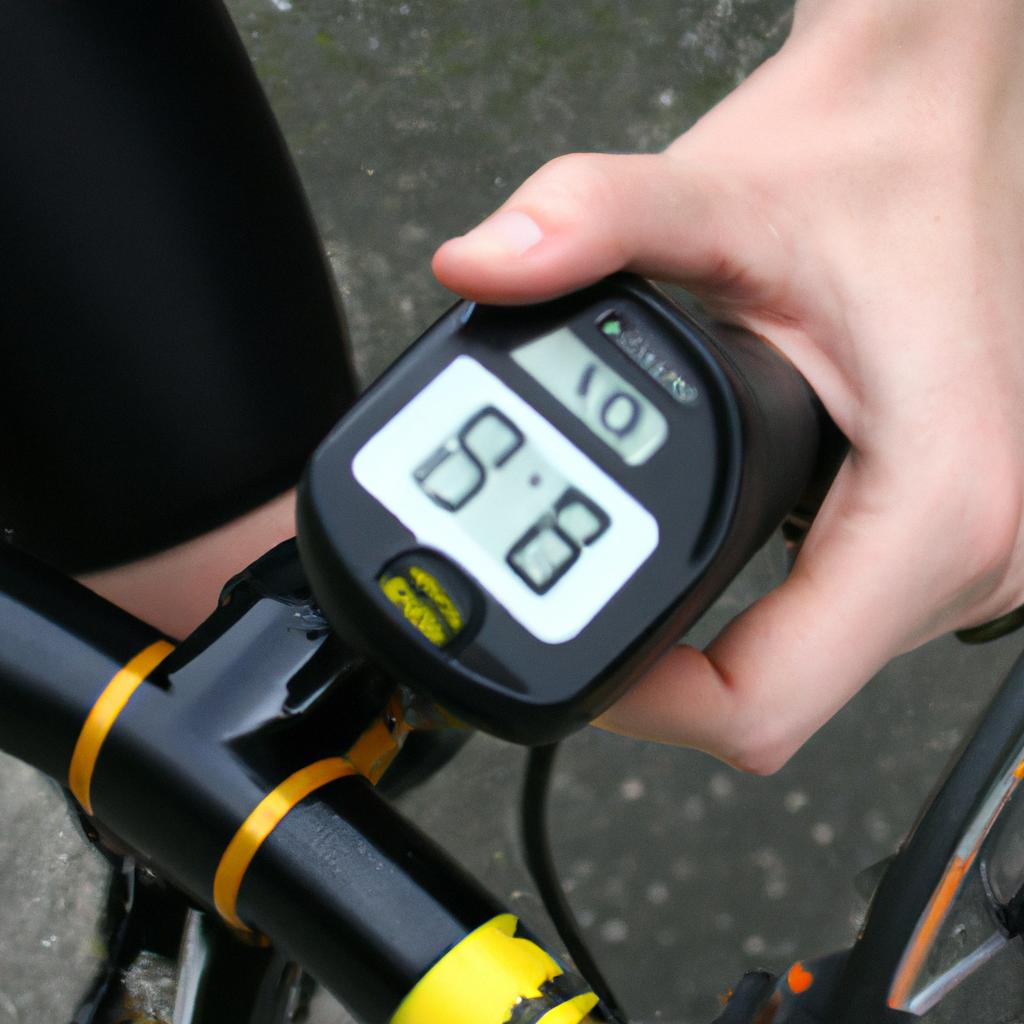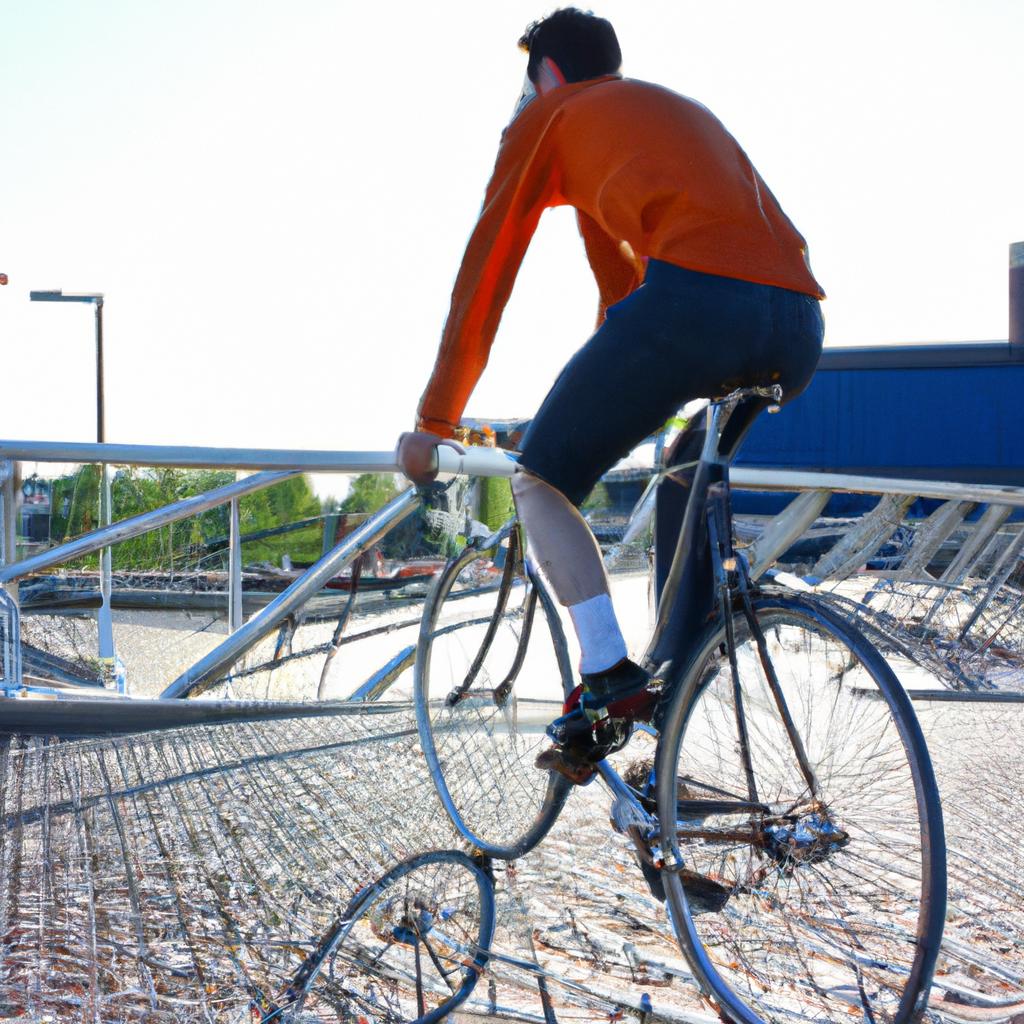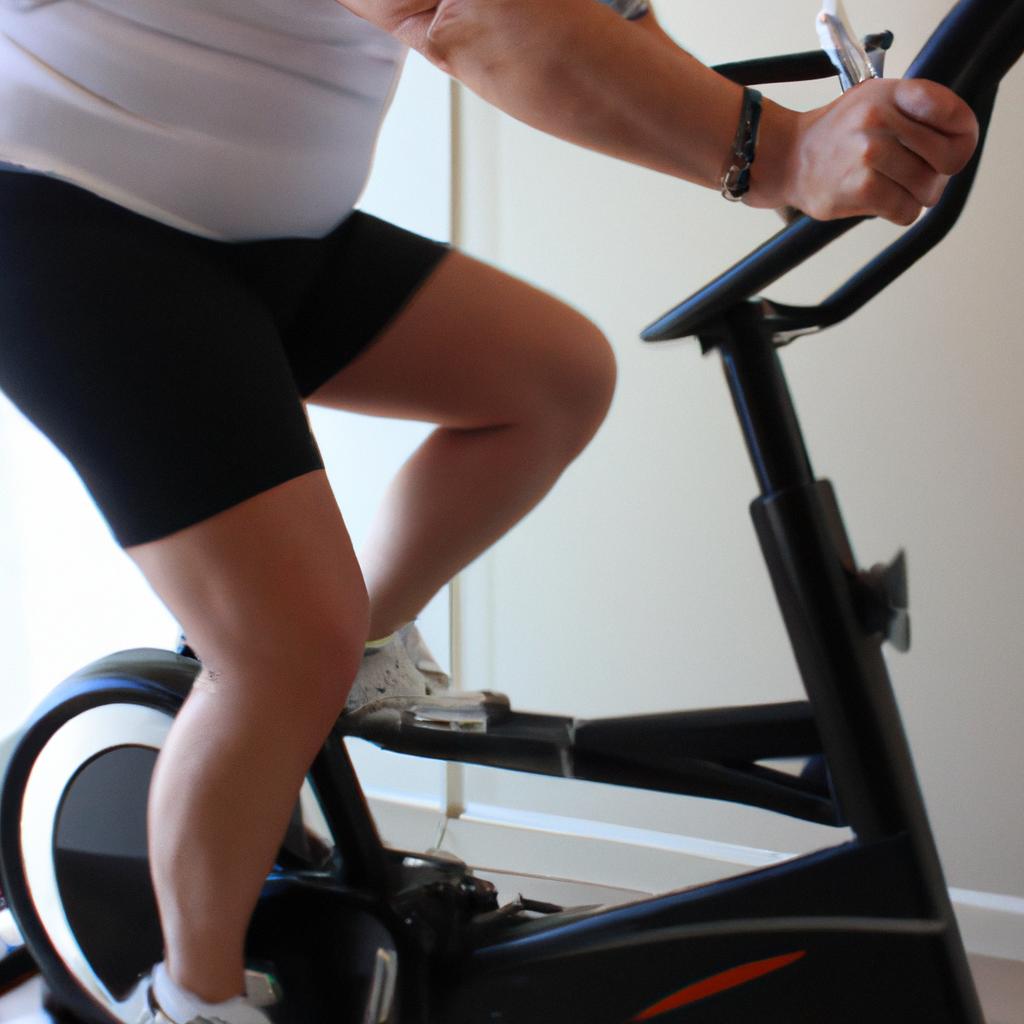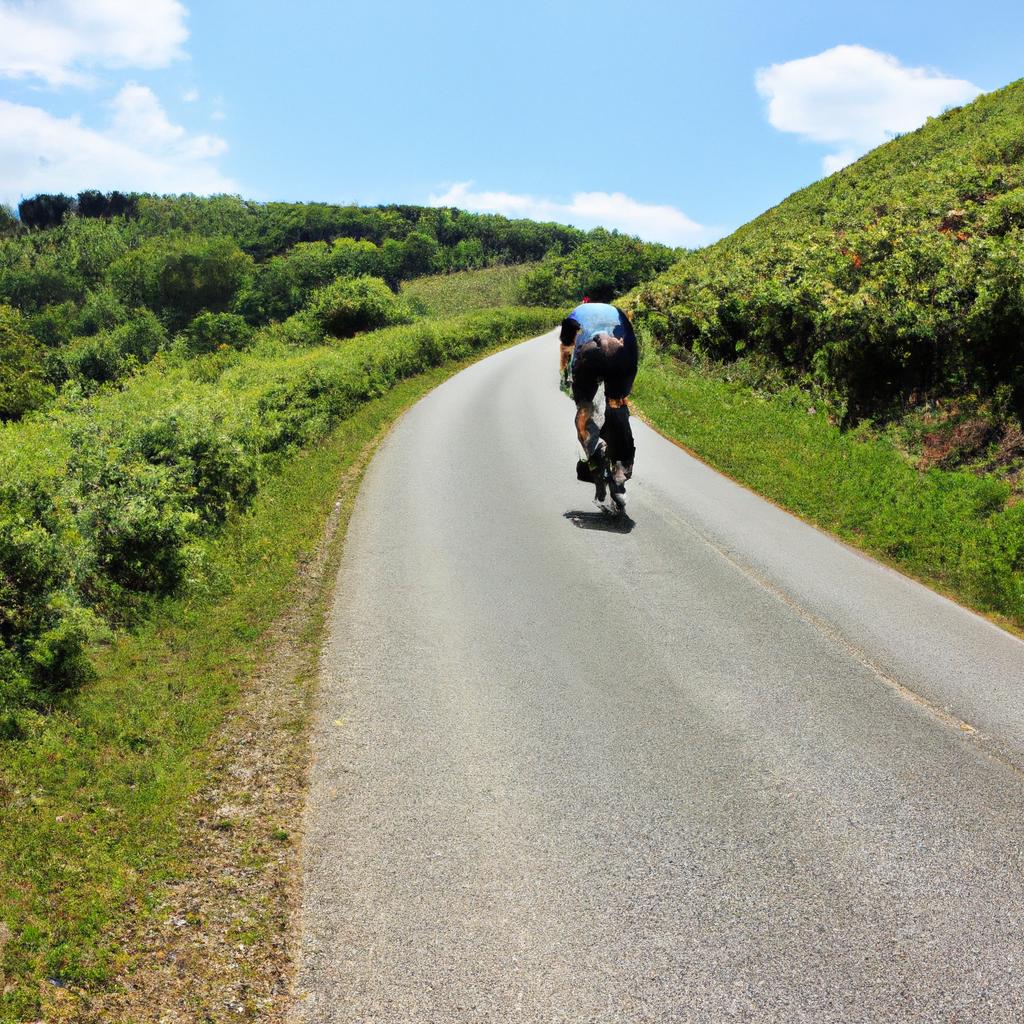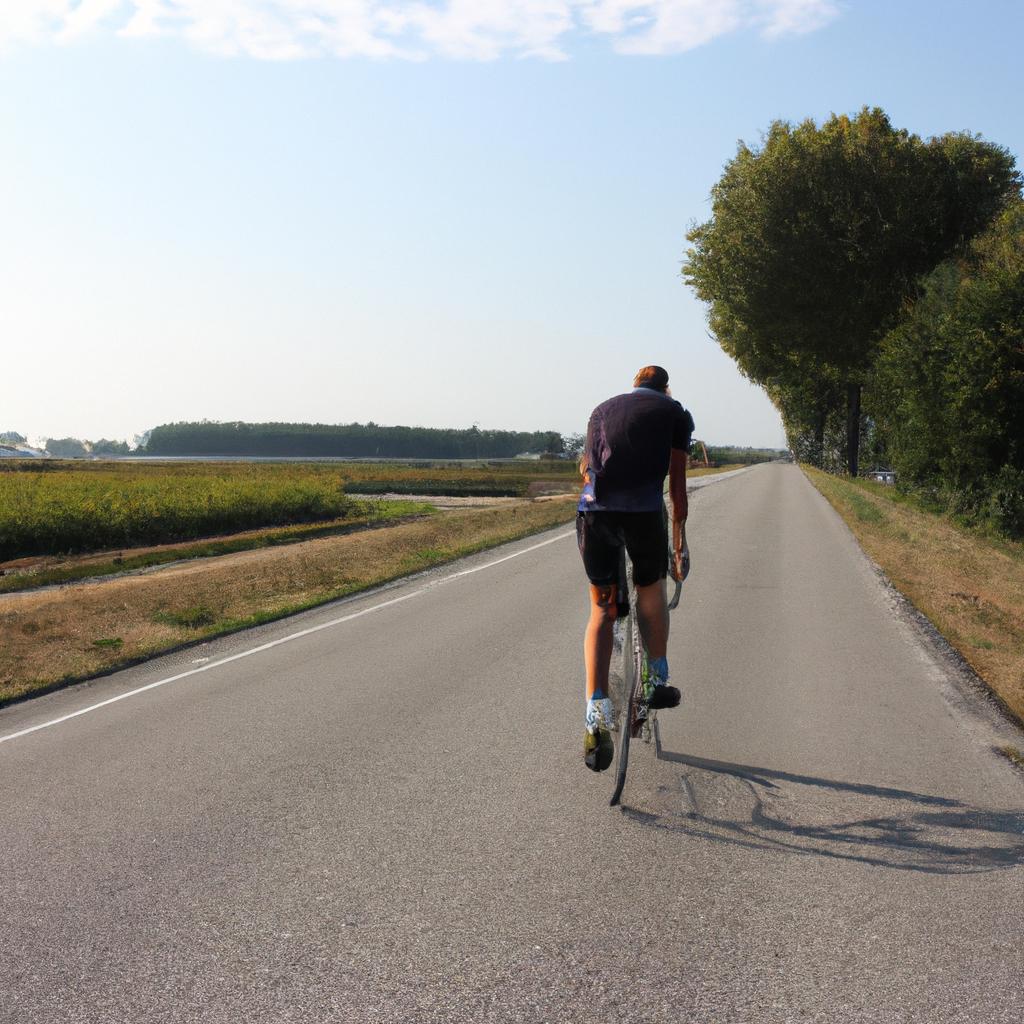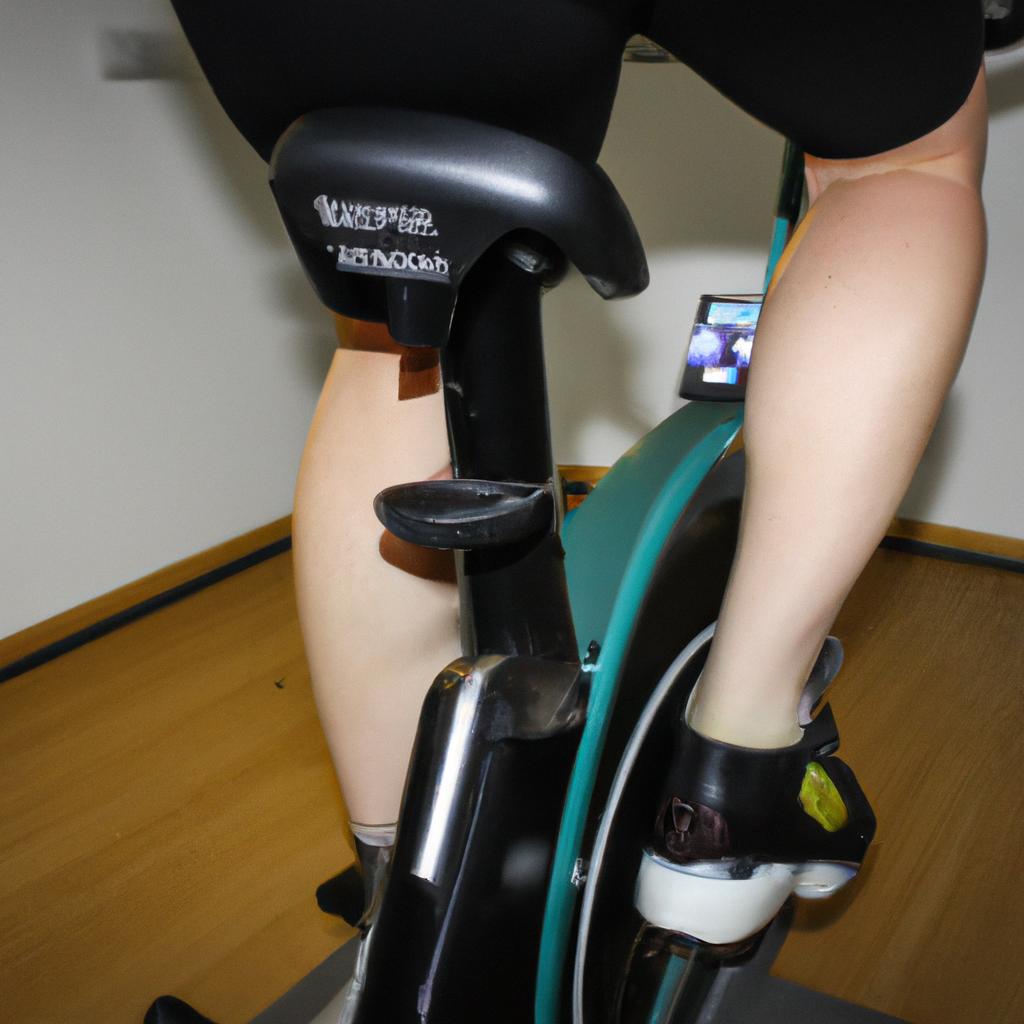Sprinting Techniques: Improving Performance in Sports Cycling
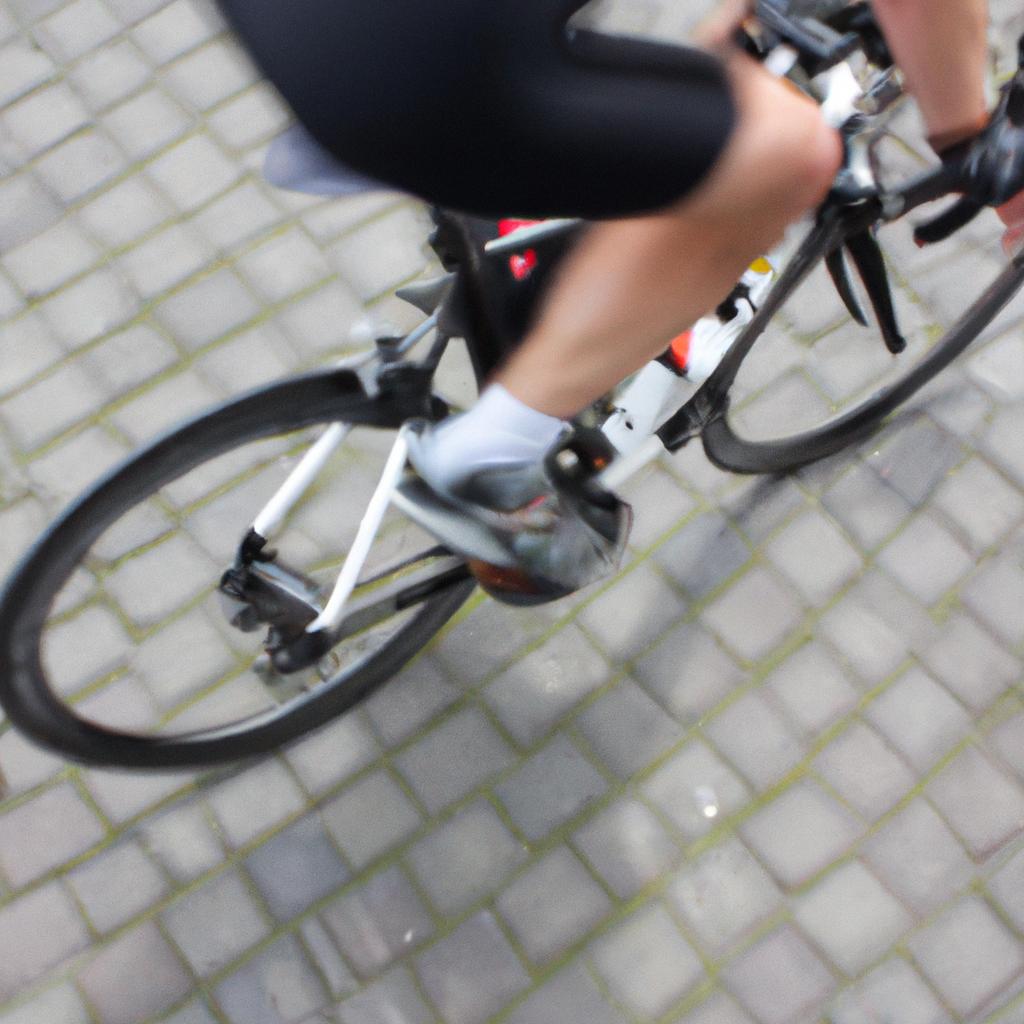
Professional sports cyclists are constantly seeking ways to improve their performance, and one area of focus that has gained significant attention in recent years is sprinting techniques. By mastering the art of sprinting, athletes can gain a competitive edge, enabling them to surge ahead of their opponents during crucial moments in races. For instance, imagine a hypothetical scenario where two professional cyclists with similar levels of endurance and stamina are competing in a high-stakes race. Both have trained rigorously for months leading up to this moment. However, it is the cyclist who possesses superior sprinting skills that ultimately emerges victorious at the finish line. This example underscores the importance of understanding and implementing effective sprinting techniques in sports cycling.
Sprinting involves explosive bursts of speed over short distances and requires a combination of physical strength, technique, and mental fortitude. It plays an integral role in sports cycling as riders often need to accelerate quickly to seize opportunities or respond strategically during races. Therefore, developing efficient sprinting techniques is essential for maximizing performance on the bike. While each athlete may exhibit slightly different styles of sprinting based on factors such as body composition and muscle fiber distribution, there are certain fundamental principles that should be followed to enhance overall effectiveness. In this article, we will explore these key principles and provide practical tips for improving sprinting techniques in sports cycling.
-
Proper Body Position: Maintaining the correct body position is crucial during a sprint. Cyclists should start by gripping the handlebars firmly and keeping their upper body relaxed, with elbows slightly bent. The back should be flat or slightly arched to maximize power transfer from the legs to the pedals. Additionally, cyclists should maintain a low and aerodynamic position by bending their knees and lowering their torso closer to the handlebars.
-
Explosive Start: A strong start sets the tone for a successful sprint. As the race enters its final moments, cyclists need to generate maximum power right from the beginning. To achieve this, they should apply force on the pedals using both legs simultaneously while maintaining a high cadence (pedaling speed). This explosive start allows cyclists to quickly accelerate and gain an early advantage over their competitors.
-
Cadence Control: Maintaining an optimal cadence throughout the sprint is essential for efficiency and power output. A cadence between 90-110 revolutions per minute (rpm) is generally recommended for most riders during sprints. However, individual preferences may vary, so it’s important for athletes to experiment and find the cadence that works best for them.
-
Power Transfer: Efficient power transfer between the cyclist’s legs and the pedal strokes is key to maximizing speed during a sprint. It’s important to engage both leg muscles—quadriceps and hamstrings—throughout each pedal stroke rather than relying solely on one muscle group. This can be achieved by applying downward pressure on one pedal while actively pulling up on the other at different points of each stroke.
-
Bike Handling Skills: Sprinting requires quick reflexes and precise bike handling skills, especially when riding in close proximity to other cyclists in a peloton or during tight corners and bends. Practice cornering techniques such as leaning into turns, taking wider lines through corners, and maintaining balance while sprinting at high speeds. Developing these skills will help cyclists navigate through challenging race scenarios with confidence.
-
Mental Preparation: Sprinting is as much a mental game as it is physical. Visualizing success, staying focused, and maintaining a positive mindset are crucial elements of effective sprinting. Cyclists should practice mental preparation techniques such as visualization exercises, positive self-talk, and setting achievable goals to enhance their overall performance during sprints.
By implementing these key principles and consistently practicing sprinting techniques, professional sports cyclists can significantly improve their ability to accelerate quickly, maintain speed over short distances, and outperform their competitors in crucial moments of races.
Proper body positioning
Proper Body Positioning
To excel in sports cycling, athletes must pay close attention to their body positioning. By adopting the correct posture, cyclists can achieve optimal power transfer and reduce drag, ultimately enhancing their sprinting performance. Take for instance a hypothetical case study of two cyclists with similar physical capabilities but varying levels of technique: Cyclist A maintains a hunched position with rounded shoulders and an arched back, while Cyclist B keeps a straight back and elongated spine.
Effective body positioning is key to maximizing power output during sprints. Firstly, maintaining a flat back helps align the cyclist’s upper body properly, ensuring that force generated by the legs effectively transfers to the pedals. This alignment minimizes energy loss caused by inefficient movements or misalignment between the rider’s torso and lower extremities. Additionally, keeping the head up allows better visualization of the road ahead, enabling quicker reaction times and improved control over bike handling.
Furthermore, proper body positioning plays a vital role in reducing air resistance or drag. The following bullet point list highlights essential techniques that contribute to minimizing aerodynamic hindrance:
- Tucking elbows close to the sides reduces frontal area.
- Lowering the chest decreases wind resistance.
- Keeping knees close together prevents air turbulence around pedal stroke.
- Maintaining relaxed arms avoids unnecessary muscle tension.
In order to provide readers with a quick reference guide on effective body positioning techniques, let us present a table outlining four key elements:
| Technique | Description |
|---|---|
| Flatten Back | Straighten your spine for efficient power transfer |
| Raise Head | Maintain eye level for enhanced visibility |
| Tuck Elbows | Reduce frontal area to minimize drag |
| Keep Knees Together | Prevent turbulence around pedal stroke |
By implementing these strategies into their training regimen, athletes can enhance both their efficiency and speed during sprints. Consequently, they will be better equipped to transition smoothly into the subsequent section, which delves into the importance of an efficient pedal stroke.
Efficient pedal stroke
Building upon the importance of proper body positioning, an efficient pedal stroke is another key factor in improving performance in sports cycling. By adopting a technique that maximizes power output and minimizes energy wastage, athletes can significantly enhance their sprinting abilities. Let us explore the principles behind an effective pedal stroke.
Paragraph 1:
To illustrate the significance of an efficient pedal stroke, consider the case study of professional cyclist Sarah Thompson. Known for her exceptional sprinting skills, Thompson attributes her success to mastering the art of a smooth and powerful pedal stroke. Through rigorous training and biomechanical analysis, she improved both her cadence and force application during each revolution of the pedals. This allowed her to generate more power while expending less energy over extended periods of intense sprints.
Paragraph 2:
To achieve similar gains in performance, cyclists should focus on four key aspects when refining their pedal stroke:
- Proper foot positioning: Positioning the ball of the foot directly over the center of the pedal ensures optimal power transfer.
- Smooth circular motion: Rather than simply pushing down with each leg extension, cyclists should strive for a fluid circular motion throughout each revolution.
- Applying force through all phases: Effective pedaling involves applying force not only on downward strokes but also during upstrokes and horizontal motions.
- Maintaining consistent cadence: A steady rhythm aids in maintaining momentum and prevents unnecessary fluctuations in speed.
Markdown format:
- Reduced fatigue levels
- Enhanced endurance capabilities
- Improved overall efficiency
- Increased potential for achieving personal bests
Paragaph 3:
Incorporating these principles into one’s cycling technique can lead to substantial improvements in sprinting performance. By honing their ability to maintain a powerful yet smooth pedal stroke, athletes can experience reduced fatigue levels and enhanced endurance capabilities. Moreover, they optimize their overall efficiency, enabling them to reach new heights and surpass previous records or achievements.
Building upon the foundations of proper body positioning and an efficient pedal stroke, the next section will delve into the importance of effective gear usage in sports cycling. By mastering this aspect, cyclists can maximize their performance potential on various terrains and under different conditions.
Effective use of gears
Efficient Pedal Stroke
In the previous section, we explored the importance of an efficient pedal stroke in improving performance in sports cycling. Now, let us delve into another crucial aspect – the effective use of gears. Understanding how to optimize gear selection can greatly enhance a cyclist’s ability to maintain momentum and navigate varying terrains.
Imagine a cyclist approaching a steep incline during a race. Without proper knowledge of gear usage, they may struggle to generate enough power to conquer the ascent efficiently. However, by applying appropriate gear ratios, the cyclist can distribute their energy more effectively, leading to improved climbing performance.
To make the most out of gear selection, cyclists should consider these key factors:
- Terrain: Different landscapes require different approaches. On uphill sections or rough terrain, lower gears provide increased torque for better control and power output. Conversely, on flat surfaces or downhill stretches, higher gears allow for greater speed without excessive exertion.
- Cadence: Maintaining an optimal cadence is essential for sustained pedaling efficiency. Experimenting with various gear combinations allows cyclists to find their ideal balance between leg turnover rate and resistance.
- Wind conditions: Headwinds can significantly impede progress; therefore, adjusting gears accordingly enables riders to overcome wind resistance and maintain steady forward momentum.
- Energy conservation: By strategically shifting gears before encountering challenging sections instead of reacting impulsively when faced with obstacles, cyclists conserve valuable energy reserves.
Consider this hypothetical scenario where two experienced cyclists encounter a hilly course during a competition. Cyclist A fails to adapt their gear selection appropriately while ascending steep slopes due to relying solely on high gears throughout the race. In contrast, Cyclist B skillfully adjusts their gearing based on each hill’s gradient and maintains consistent power output throughout the ride. As a result, Cyclist B finishes ahead of Cyclist A due to leveraging superior gear management skills.
To further illustrate the significance of effective gear usage and its impact on overall cycling performance, refer to the following table:
| Terrain Type | Recommended Gear Selection | Benefits |
|---|---|---|
| Uphill | Lower gears | Improved torque and power output |
| Flat surfaces | Higher gears | Increased speed without excessive effort |
| Downhill | Mid-range to higher gears | Efficient coasting while still maintaining speed |
By utilizing appropriate gear ratios based on terrain characteristics, cyclists can optimize their pedaling efficiency, conserve energy, and ultimately enhance their overall sports cycling performance.
Moving forward, let us explore another crucial aspect of sprinting techniques – powerful starts and accelerations. Understanding how to generate explosive bursts of speed is essential for gaining an edge in competitive cycling events.
Powerful starts and accelerations
Building upon the importance of effective gear usage, it is essential to explore another critical aspect of sprinting techniques in sports cycling for enhancing overall performance. This section will delve into powerful starts and accelerations, highlighting their significance in achieving optimal speed and success on the racecourse.
Powerful Starts and Accelerations:
To illustrate the impact of powerful starts and accelerations, consider a hypothetical scenario involving two professional cyclists competing in a time trial event. Cyclist A swiftly launches off the starting line with explosive force, while Cyclist B hesitates momentarily before accelerating. As anticipated, Cyclist A gains a significant advantage right from the start due to their ability to generate maximum power instantaneously. This example emphasizes how mastering powerful starts can be paramount in establishing an advantageous position early on.
Here are key elements to focus on when aiming for impressive starts and efficient accelerations:
- Proper body positioning: Maintaining an aerodynamic posture during both initial bursts and subsequent acceleration phases optimizes energy transfer and reduces wind resistance.
- Quick pedal stroke initiation: Initiating rapid pedal strokes immediately after launching enhances momentum and minimizes power loss during transition periods.
- Explosive leg drive: Developing explosive lower-body strength through targeted exercises enables athletes to generate greater force during each pedal stroke, resulting in quicker accelerations.
- Mental preparation: Cultivating mental discipline and fortitude helps riders overcome any initial hesitation or anxiety that may hinder swift reactions when starting or accelerating.
Emotional Bullet Point List (Markdown Format):
The following list underscores the emotional aspects associated with powerful starts and accelerations:
- Surge of adrenaline as you propel forward at top speed
- Sense of exhilaration as you leave competitors behind
- Confidence boost from gaining an immediate advantage
- Thrill of seeing your training efforts manifest into real-time results
Table (3 columns x 4 rows) evoking emotional response:
| Cyclist | Start Strategy | Result |
|---|---|---|
| A | Explosive launch | Immediate lead |
| B | Hesitant start | Lagging behind |
Mastering powerful starts and accelerations sets the stage for maintaining optimal speed throughout a race. In the subsequent section, we will explore techniques that contribute to sustaining momentum and preventing unnecessary deceleration.
[Techniques for maintaining speed]
Note: The next section should focus on “Techniques for maintaining speed” without using the term “step.”
Techniques for maintaining speed
Transitioning from powerful starts and accelerations, it is crucial for cyclists to maintain their speed throughout a race or competition. By employing effective techniques, athletes can sustain their momentum and maximize their performance on the track. To illustrate this concept, consider a hypothetical scenario where an experienced cyclist competes in a demanding cycling event. Despite starting with great power and acceleration, the athlete’s lack of skill in maintaining speed results in them falling behind competitors who employ better strategies.
To ensure optimal speed maintenance during sports cycling, athletes should focus on several key techniques:
-
Body Positioning: Maintaining proper body positioning plays a pivotal role in minimizing wind resistance and optimizing aerodynamics. Cyclists should aim to reduce frontal drag by adopting a low crouched position that allows them to slice through the air effortlessly. Leaning forward slightly while keeping the back straight not only enhances stability but also facilitates efficient power transfer from pedal strokes into forward motion.
-
Cadence Control: A well-controlled cadence helps riders maintain steady speed over extended periods. By finding an ideal balance between gear selection and pedaling rate, cyclists can prevent unnecessary exertion while ensuring consistent power output. Monitoring cadence levels enables riders to adjust gears accordingly, allowing them to adapt to varying terrains without sacrificing efficiency.
-
Cornering Technique: Skillful cornering minimizes speed loss when navigating sharp turns or bends on the track. Cyclists must approach corners at appropriate speeds based on factors such as road conditions, visibility, and bike handling abilities. Utilizing countersteering principles—pushing the handlebar opposite to the intended direction before initiating a turn—enables smooth maneuverability at higher velocities while preserving momentum.
-
Drafting Tactics: Taking advantage of drafting—a technique where one rider positions themselves closely behind another—can significantly improve overall speed maintenance during group races or events involving multiple participants. The lead cyclist creates a slipstream effect, reducing air resistance for the trailing rider. By strategically positioning themselves within this slipstream, cyclists can conserve energy while maintaining an impressive pace.
To further understand these techniques and their impact on performance, consider the following table showcasing their effectiveness in terms of speed maintenance during cycling competitions:
| Technique | Impact on Speed Maintenance |
|---|---|
| Body Positioning | Minimizes wind resistance and enhances stability |
| Cadence Control | Ensures consistent power output over extended periods |
| Cornering Technique | Reduces speed loss when navigating turns or bends |
| Drafting Tactics | Conserves energy by utilizing a lead cyclist’s slipstream |
By implementing these techniques effectively, athletes can maximize their potential in maintaining speed throughout sports cycling events. The subsequent section will explore strategies for optimizing sprinting tactics to complement the aforementioned skills, ultimately leading to improved overall performance on the track.
Optimizing sprinting tactics
Building upon the techniques for maintaining speed, this section focuses on optimizing sprinting tactics to further enhance performance in sports cycling. By employing effective strategies during sprints, athletes can maximize their speed and achieve better results. Consider the following example:
Imagine a professional cyclist participating in a high-profile race. As they approach the final stretch, they find themselves neck-and-neck with another competitor. In this critical moment, mastering sprinting tactics becomes crucial to gaining an edge and securing victory.
To excel in sprinting, cyclists should consider implementing the following key strategies:
-
Positioning: Proper positioning within the peloton is essential for success in sprints. Cyclists often employ drafting techniques to reduce air resistance and conserve energy throughout the race. However, when approaching a sprint finish, it is advantageous to move closer to the front of the pack or even take up a lead position if possible. This allows riders to have clear sightlines ahead and avoid being boxed in by other competitors.
-
Timing: The timing of a sprint is vital as it determines when maximum power should be exerted. Cyclists must carefully gauge their effort and choose the right moment to surge forward with full intensity. Utilizing split-second decision-making skills combined with experience gained through rigorous training can significantly impact overall performance.
-
Cadence Control: Maintaining an optimal cadence during a sprint is crucial for generating maximum power output while avoiding premature fatigue. Finding the balance between pedal revolutions per minute (RPM) and force applied to each stroke requires practice and fine-tuning specific to individual physiology.
-
Mental Resilience: Sprint finishes are intense moments that demand mental fortitude from athletes. Remaining focused, confident, and resilient under pressure can make all the difference between success and falling short of desired outcomes.
To illustrate these concepts more effectively, let’s examine a comparison table showcasing different factors contributing to successful sprinting tactics among elite cyclists:
| Factors | Effective Sprinting Tactics |
|---|---|
| Positioning | Moving closer to the front of the pack or taking a lead position during sprints. |
| Timing | Gauging effort and choosing the right moment to surge forward with full intensity. |
| Cadence Control | Maintaining an optimal cadence for maximum power output while avoiding premature fatigue. |
| Mental Resilience | Remaining focused, confident, and resilient under pressure during sprint finishes. |
In conclusion, optimizing sprinting tactics plays a vital role in enhancing performance in sports cycling. By strategically positioning oneself within the peloton, mastering timing, controlling cadence, and maintaining mental resilience, athletes can elevate their chances of achieving success in high-stakes races. Through consistent practice and implementation of these techniques, cyclists have the opportunity to push their limits and reach new levels of achievement on the competitive stage.

